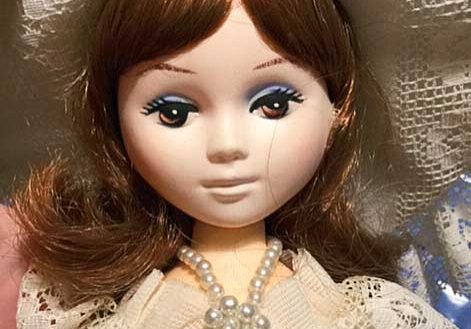
Antiques Expert: Doll valuation
by Northern Life
Dear Allan,
I bought a doll from an antique mall in Canada a few years ago for $75. She has an old chipped wooden stand that probably used to have a doll company name on the bottom, but at the moment all I can see is the word ‘dolls.’ Her face looks hand painted but I don’t actually know if it is and she has a realistic lace dress and hoop skirt. Her face is noticeably much lighter than the rest of her skin too. I don’t know anything about who owned her before I bought her, but I’ve always assumed that she was from the 1950s.
Thank you.
Mrs Hilder, Blackburn
For literally thousands of years, children have played with dolls. Their popularity has been sustained from the earliest, primitive, wooden dolls to the walking, talking, living dolls of the present day!
Nowadays, it’s not just children that are on the look-out for a new doll. Many adults collect dolls, some choosing to house a collection of dolls they just like to look at, whilst others deal in dolls, some of which can change hands for considerable sums of money. Unfortunately, your doll would fall in to the first category. She is very pretty and would make a nice part of a collection, but I fear she is worth very little and without seeing her close up, I really can’t give you an accurate valuation.
Straight away I can see that the head does not match the body. The head could be quite old, but her legs are definitely new. in fact they look like they belong to a Barbie or sindy doll.
The usual procedure was to make the head first and put the body on later. Dolls from about 1900s would have had a body made of leather or cloth. Whatever period your head is from somehow along the way, this body has been changed.
Also, the base has been introduced later too. dolls like this would not have been displayed on a stand. Collectors like to see dolls in both a sitting and standing position, so the base is an ‘add on’ that doesn’t add anything to the value. I think it’s been added because the legs are flimsy and wouldn’t hold the weight of the top half of the doll (made from a heavier material).
The most important part of an old doll is the base of the neck. If you pull her long hair back there should be a maker’s mark there.
Very often the hair can be glued down which makes it very hard to see the markings. So often people bring their favourite dollies into the centre for me to value and i can’t give a true valuation without gently having to pull some of the hair away from the neck and that’s never good. Hair would have been crafted from horse hair or even human hair. dolls that have clear markings at the base of the neck are generally the most valuable. as well as just the date, the mark also tells us the country of origin and the manufacturer.
I’m sorry it’s not better news for you financially, but she is pretty, the head could be old and the dress is quite nice too.
If you want to continue to collect dolls, remember that any doll over 50 years old is considered collectable.
Collectors classify dolls according to the material used to make the head. Dolls heads were made from wax, wood, papier mache or china, but the bodies could be made from wood, leather or cloth.
It wasn’t just the materials that changed over time – before 1860 most dolls were modelled on fashionable women – they were dressed in period costume and were ‘little ladies’.
It was not until queen Victoria’s strong family values put the emphasis back on to children that dolls became more childlike. made from 1840-1910, in immense numbers, these so-called Chinas are judged by the delicacy of the facial painting, the translucency of the porcelain and the modelling of the face and hair. The most everyday features are the most sought after – dolls with brown hair (rather than black) and brown or grey eyes (instead
of the commoner blue) are more valuable. A china headed doll in original costume could be worth £200.
However, the rarest (and most sought after) dolls are the French Fashion dolls of the mid-late 19th Century. (ironically, it was the dolls’ clothes and not the dolls themselves which were originally valuable). These beautiful dolls were equipped with wardrobes of clothes, as well as trunks full of accessories.
This concept of a doll sold purely on the size of her wardrobe was proved again almost 100 years later with the arrival of Barbie.
Ten years ago dolls were worth twice as much as they are today – collectors seem to have fallen out of love with them recently. Lots of early dolls were not pretty. they could be quite ugly, scary things with staring eyes.
The most important thing that collectors need to remember is that the only way to keep the value of a doll, is to keep it in its original clothes. Whilst it means you have to be very careful how you play with them, it’s the best way to secure them as collectables of the future!
To have your antiques and collectibles valued, please send your letters and photos to info@northernlifemedia.co.uk.
GB antiques Centre stresses that valuations given are an indication for insurance purposes only and are not necessarily what the item would sell for. readers should also note that valuations are based on submitted photographs and any additional information provided by their owners. These valuations are intended to be indicative, not conclusive.






